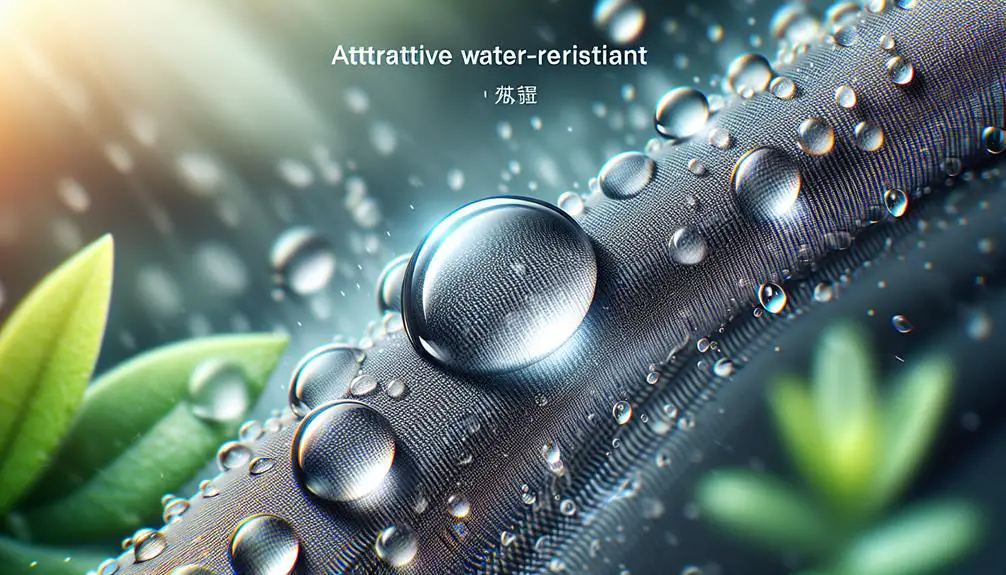Nylon isn't naturally waterproof, but it's got a few tricks up its sleeve to handle moisture. This synthetic material, born in the 1930s, has a knack for taking on waterproof qualities with a little help. By itself, nylon can resist some water, but when it faces the real downpour test, it needs backup. Enter waterproof coatings like silicone or polyurethane and techniques like laminating which seriously boost its water resistance. Even the way nylon is woven can play a part in keeping you dry. So while nylon alone won't quite cut it, with the right treatment, there's a lot more to it.
Table of Contents
Key Takeaways
- Nylon material itself is not inherently waterproof but offers some water resistance.
- Water resistance in nylon can be enhanced with coatings such as silicone, polyurethane, or PVC.
- The degree of water resistance in nylon varies depending on the type and density of the fabric.
- Waterproof treatments like DWR (Durable Water Repellent) coatings improve nylon's ability to repel water.
- Prolonged exposure to water or high pressure can compromise the water resistance of untreated nylon.
Understanding Nylon Material
Nylon, a synthetic material first developed in the 1930s, is renowned for its strength, durability, and versatility. Originating from petroleum, nylon emerges through a fascinating process called polymerization. Here, long chains of synthetic polymers are formed, which include repeated amide groups integral to the material's robust characteristics.
Diving deeper, it's the molecular structure of nylon that really sets it apart. This structure grants the material not just a high tensile strength important for heavy-duty uses but also a notable flexibility that's essential in various applications, from clothing to industrial products. Additionally, nylon's abrasion resistance is a key attribute, allowing it to withstand wear and tear better than many natural fibers.
What's intriguing is that despite its many strengths, nylon is hydrophilic. This means it naturally attracts water, which influences its water resistance properties—something we'll explore more deeply later. Understanding these aspects of nylon helps in appreciating how this durable, synthetic material performs under different conditions, making it a staple in an array of applications. Its reliance on petroleum also highlights its synthetic roots and ties to industrial chemistry.
Nylon's Water Resistance
Let's unpack how nylon interacts with water and what makes it resistant.
We'll explore how to boost this resistance for various uses, from everyday items to specialized gear.
Understanding these properties helps us see why nylon is a popular choice for waterproof applications.
Nylon Absorption Properties
I've found that nylon's ability to resist water comes from its unique molecular structure, where hydro bonds form a barrier against moisture. This molecular arrangement significantly boosts the fabric's water resistance.
The effectiveness of this resistance isn't uniform across all nylon types; it varies significantly, with measurements ranging from 1000mm to 20000mm. These ratings are assessed through grams/1000m thread and fabric density, which gauge how well the material can fend off water infiltration.
However, it's important to note that nylon's water resistance can diminish with prolonged exposure or under high pressure. These factors can wear down the protective hydro bonds over time, reducing the fabric's ability to repel water effectively.
Enhancing Nylon's Resistance
To boost its water resistance, nylon can be treated with waterproof coatings like silicone or polyurethane. The molecular structure of nylon, featuring hydro bonds, naturally protects against some water infiltration. However, for more robust protection, especially in diverse environmental conditions, enhancing this resistance through chemical and physical modifications is crucial. Techniques like laminating nylon with PVC plastic or integrating perfluoroalkyl groups can significantly elevate its ability to repel water.
Here's a quick breakdown of enhancements:
| Enhancement Type | Method |
|---|---|
| Coating | Silicone, Polyurethane |
| Plastic Layer | PVC |
| Chemical Groups | Perfluoroalkyl |
| Fabric Design | Tighter Weave |
| Molecular Bonds | Hydro Bonds |
Understanding these options helps in selecting the right type for specific needs.
Practical Waterproof Applications
Nylon's water resistance makes it a popular choice for outdoor gear and rainwear. Delving into this property, it's clear that the molecular structure of nylon, specifically the hydro bonds, plays a pivotal role. These bonds form a protective layer that's crucial in preventing water infiltration. However, it's not about absolute waterproofing; rather, nylon offers varying degrees of protection based on its fabric density and the grams/1000m thread measurement.
When faced with high pressure or prolonged exposure, the effectiveness of these hydro bonds can diminish. This highlights a limitation in nylon's ability to completely block water under all circumstances, emphasizing the importance of understanding its capabilities and limits for force prevention in water-resistant applications.
Waterproof Treatments for Nylon
Various treatments, like durable water repellent (DWR) coatings, can effectively make nylon waterproof. These treatments are crucial because they enhance the fabric's ability to resist moisture, crucial for outdoor gear. DWR coatings work by altering the surface tension on the nylon. This modification causes water to bead up and roll off rather than soaking in. It's a straightforward yet powerful way to prevent water absorption and keep the material dry.
Beyond DWR, other coatings like silicone, polyurethane, and PVC plastic also serve to waterproof nylon. Each of these has its own method of blocking moisture. Silicone, for instance, adds a high level of water repellency, thereby increasing the durability of the nylon fabric against wet conditions. Polyurethane coatings add a robust layer over the nylon, preventing water from penetrating the material. PVC plastic, often used in heavier applications, coats the nylon in a thick, impermeable layer.
Incorporating these treatments into nylon fabrics not only boosts their performance in wet environments but also extends their overall lifespan by protecting them against harsh weather conditions. So, whether it's a raincoat or a camping tent, treated nylon stands up to the challenge, keeping moisture out effectively.
The Science of Waterproofing
Understanding how nylon becomes waterproof involves a deep dive into its molecular structure and the use of specific treatments. Now, nylon's molecular structure is fascinating because it includes hydro bonds that naturally create a protective layer. This isn't a full barrier but it does provide basic water resistance. However, when we talk about making nylon fabrics truly waterproof, that's where additional treatments come into play.
To enhance nylon's water resistance, manufacturers often apply waterproof coatings like silicone or polyurethane. These coatings effectively seal the fabric, preventing water penetration even under higher pressures. But there's more to it than just slapping on some silicone. The process also may involve chemically modifying the nylon by integrating specific chemical groups that bolster the fabric's defense against water.
This scientific approach ensures that the water resistance of nylon can be quantified—typically in millimeters of water pressure the fabric can withstand. It's crucial to understand that while these treatments improve water resistance, they don't make the fabric invincible. Prolonged exposure or extremely high pressure can still compromise the protective layer. Thus, the science of waterproofing nylon is all about enhancing and measuring its ability to resist water penetration effectively.
Water Resistance Vs. Waterproof
While both terms might sound similar, water resistance and waterproof in the context of nylon signify different levels of moisture protection. Let's break it down.
Nylon's water resistance stems largely from its molecular structure and the formation of hydro bonds. These features block some water from infiltrating the material. We measure this capability in terms of grams per 1000m thread and the fabric's density. It's not absolute, though; nylon will repel water to a point, but with enough exposure, moisture breaks through.
Waterproofing takes this a step further. By applying coatings like silicone, polyurethane, or PVC, nylon's resistance is significantly enhanced. These coatings essentially seal the fabric, creating a barrier that water can't penetrate at all. It's a game-changer for anyone needing reliable moisture protection.
Standards in Waterproofing
When we talk about how well a material like nylon holds up against water, it's crucial to understand the standards it's tested against.
There's a range of criteria that define how fabrics are certified for waterproofing, including how they're tested and how they perform over time.
Knowing these can really help when you're picking out gear that needs to stand up to the elements.
Waterproofing Certification Criteria
Waterproofing certification criteria categorize levels of protection using letters or numbers, like IPX7 or ATM, which indicate how well a material can resist water under specific conditions. Understanding these standards is crucial for selecting the right products for your needs, especially when dealing with materials like nylon and their inherent waterproof properties.
| Standard | Description | Use Case |
|---|---|---|
| IPX7 | Water immersion | Devices used near water |
| ATM | Water pressure | Watches, depth exposure |
| IP68 | Water and dust ingress | Outdoor and rugged use |
| IPX0 | No protection | Indoor use only |
| ATM 5 | 50 meters resistant | Swimming, shallow diving |
This table helps clarify how each rating can influence your product selection based on expected water exposure.
Material Testing Methods
Understanding the certification criteria helps us see how material testing methods ensure nylon and other fabrics meet waterproofing standards. In fabric testing, textiles like nylon are scrutinized under conditions set by standards such as the IP rating and W1-W5 levels. These indicate how well a fabric can resist water infiltration and pressure. For instance, a W5 rating means top-tier waterproofing, ideal for harsh environments.
Compliance with these standards is crucial. It guarantees that nylon material undergoes rigorous quality assessment, ensuring it meets the required resistance levels. This process helps manufacturers and consumers trust the product's performance against water. By adhering to these guidelines, we ensure that the fabric not only claims to be waterproof but actually stands up to the test.
Durability and Performance
To ensure durability and optimal performance, nylon fabric must meet specific waterproofing standards. When I'm choosing nylon for my projects, I always check its IP rating to understand its level of protection against water. This rating clarifies whether the material is merely water-resistant or truly waterproof.
Nylon can be treated with various coatings like silicone, polyurethane, or PVC to boost its water resistance. Each option affects the fabric differently, enhancing not just durability but also maintenance needs. Remember, the way nylon is constructed and treated determines its resistance level, typically measured in mm or grams per 1000m. Regular care is crucial since even the best-treated nylon can degrade with poor maintenance or excessive exposure to harsh conditions.
Types of Water-Resistant Nylon
Nylon's water-resistant varieties vary in their design and application, each tailored to specific needs and environments. When we talk about water resistance in nylon, it's crucial to understand how fabric density and grams/1000m thread play into its efficacy. The denser the nylon, measured in grams per 1000 meters of thread, the more resistant it's to water penetration. This density contributes to a protective layer, thanks to nylon's molecular structure and hydro bonds, which help prevent water from seeping through.
However, it's important to recognize the limitations of nylon's natural water resistance. Under high pressure or prolonged exposure, the resistance can weaken. To combat this, various waterproof coatings are applied. Silicone and polyurethane are popular choices for enhancing the water resistance of nylon fabrics. These coatings add an extra layer of protection, sealing the fabric more effectively against moisture.
Maintaining Water-Resistant Nylon
While we've explored how nylon can resist water, let's now look at how to keep it performing well in wet conditions. First off, when your nylon gear gets wet, proper drying techniques are crucial. Don't just toss them in a heap; spread them out or hang them up to ensure they dry evenly and completely. This step is key to maintaining the fabric's water resistance.
Avoid exposing your nylon items to prolonged water contact or high-pressure conditions, as these can weaken the material's ability to repel water. If you're keen on keeping your nylon in top shape, be mindful of fabric density and its relation to water resistance. Higher density typically offers better protection, but it still needs care.
Regularly check for signs of wear, especially if you often engage in abrasive activities. These can degrade the protective layer that enhances water resistance. If you notice any thinning or damage, consider reapplying a waterproof coating. Products like silicone or polyurethane are perfect for this and can significantly extend the lifespan of your nylon items under wet conditions.
Applications of Waterproof Nylon
When I think about the uses of waterproof nylon, the first things that come to mind are its applications in outdoor gear and protective clothing.
It's perfect for making items like tents and ponchos because it keeps you dry and withstands rough conditions.
Plus, its various color options make it a top pick for DIY enthusiasts looking to customize their gear.
Outdoor Gear Uses
Waterproof nylon is a popular choice for outdoor gear like tents and rain flys because it effectively keeps moisture out. When I'm packing for a trip, the last thing I want is my gear to get wet. That's where waterproof nylon comes in, especially fabrics like Silnylon, which are not only lightweight but also highly durable. They're perfect for everything from ground sheets to gear sacks.
Here's a quick breakdown of how waterproof nylon is used:
| Gear Type | Benefit |
|---|---|
| Tents & Rain Flys | Maximum moisture protection |
| Ponchos & Pack Covers | Keeps belongings dry |
| Gear Sacks | Protects contents |
With these uses, it's clear why waterproof nylon is essential for any outdoor enthusiast.
Protective Clothing Options
Beyond its use in outdoor gear, waterproof nylon is also a top choice for protective clothing like raincoats and jackets. Its moisture resistance and durability make it perfect for pants and other apparel designed to withstand harsh weather conditions.
When I'm gearing up for a wet or windy day, I count on my waterproof nylon gear to keep me dry and comfortable. This material isn't just limited to personal outdoor activities; its robust qualities are ideal for industrial use where protection against the elements is crucial.
Wearing waterproof nylon, whether in heavy rain or blowing wind, provides a dependable barrier, ensuring that I, and many others in various professions, remain protected and focused on the task at hand.
Testing Nylon's Water Resistance
To truly gauge how well nylon fends off water, we can test its resistance across different types and conditions. I've learned that understanding nylon's molecular structure and the role of hydro bonds is essential. These bonds form a protective layer that significantly hinders water infiltration. However, factors like fabric density and the specific type of nylon impact how this resistance measures up under various scenarios.
Here's a quick breakdown to show how different nylon types perform under testing conditions:
| Nylon Type | Water Resistance (grams/1000m) |
|---|---|
| Type A | 1000mm |
| Type B | 10000mm |
| Type C | 20000mm |
These figures illustrate the variability in nylon's water resistance. It's clear from the table that not all nylons are created equal. The higher the grams/1000m, the denser the fabric, which typically means better resistance. But it's not just about the numbers; prolonged exposure and high pressure can degrade these protective qualities. So, while nylon can be a strong ally against moisture, its effectiveness is dependent on the specific conditions and the quality of the nylon used.
Tips for DIY Waterproofing
Enhancing your nylon gear's water resistance starts with a durable water repellent (DWR) coating. Here's how I tackle DIY waterproofing to keep my gear in top shape. First, I ensure the nylon fabric is clean and dry. Applying the DWR coating on dirty or damp fabric won't cut it. The key here is altering the surface tension so that water beads up and rolls off instead of soaking in.
I spray the coating evenly, covering every inch of the fabric. It's crucial to let the fabric dry completely before testing its waterproofing capabilities. I usually hang the gear overnight in a well-ventilated area. The next day, I'll sprinkle some water on it to check if the water beads are forming. If water starts to absorb, it's a sign I need to reapply the coating.
Maintaining this water repellent layer is all about regular care. I reapply the coating periodically, especially after intense use or exposure to harsh conditions, to prevent water infiltration and keep the fabric dry. This routine ensures the longevity of the waterproofing effect, keeping my nylon gear ready for any adventure.
Innovations in Nylon Fabric
Nylon fabric has seen remarkable innovations, including the development of silnylon which combines silicone coating with a ripstop weave for enhanced durability and waterproofing. This innovation has propelled nylon into the spotlight for outdoor enthusiasts and DIY project aficionados alike. Silnylon, in particular, stands out for its lightweight yet robust qualities, making it a top choice for weather-resistant applications.
The integration of DWR coatings has further elevated nylon's ability to repel water, ensuring that items remain dry even in challenging weather conditions. This treatment enhances the fabric's waterproof capabilities without compromising its breathability, which is crucial for comfortable outdoor gear.
Moreover, the variety of color options now available in nylon fabric—ranging from subtle Green Tea to vivid Blaze Orange—provides ample creative freedom for crafting personalized gear. Whether you're looking to design a custom tent or a unique backpack, these colors can meet any aesthetic requirement.
The advancements in technology not only make nylon fabric windproof but also expand its usability across various climates and conditions. Whether it's for hiking, camping, or just a simple outdoor gathering, nylon's innovations ensure reliability and adaptability, making it an indispensable material in the realm of outdoor and DIY projects.
Frequently Asked Questions
Is 100% Nylon Water Resistant?
Yes, 100% nylon is water-resistant due to its hydro bonds and tight weave, providing a protective layer against water. However, it's not fully waterproof and can be overwhelmed by prolonged or intense exposure.
Can Water Pass Through Nylon?
Yes, water can pass through nylon, especially under prolonged exposure or high pressure. It's hydrophilic, meaning it absorbs moisture, which compromises its resistance to water over time.
What Material Is 100% Waterproof?
Silicone-coated nylon, or silnylon, is 100% waterproof. It's treated with silicone on both sides, making water bead up and roll off. It's perfect for outdoor gear like tents and backpacks.
Is Nylon Good Against Water?
I've found that nylon is quite effective against water due to its molecular structure, though it's not completely waterproof. It can withstand some moisture, but under high pressure, its resistance may diminish.
- Tetron Fabric for Marine Applications: Durability and Use Cases - June 18, 2025
- Tetron Fabric for Outdoor Furniture: Weather Resistance and Care - June 18, 2025
- Tetron Fabric for Wall Coverings: Style and Application Tips - June 18, 2025






